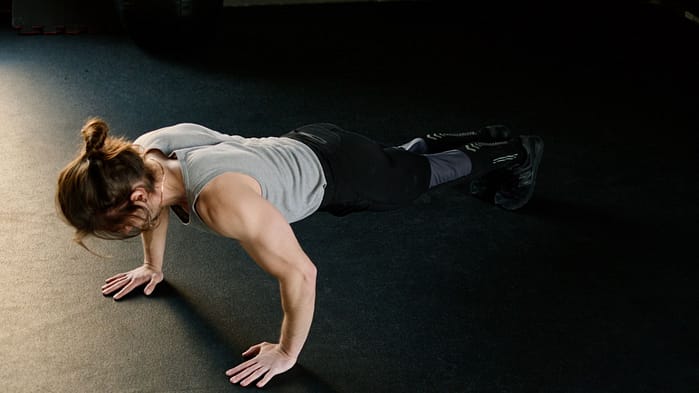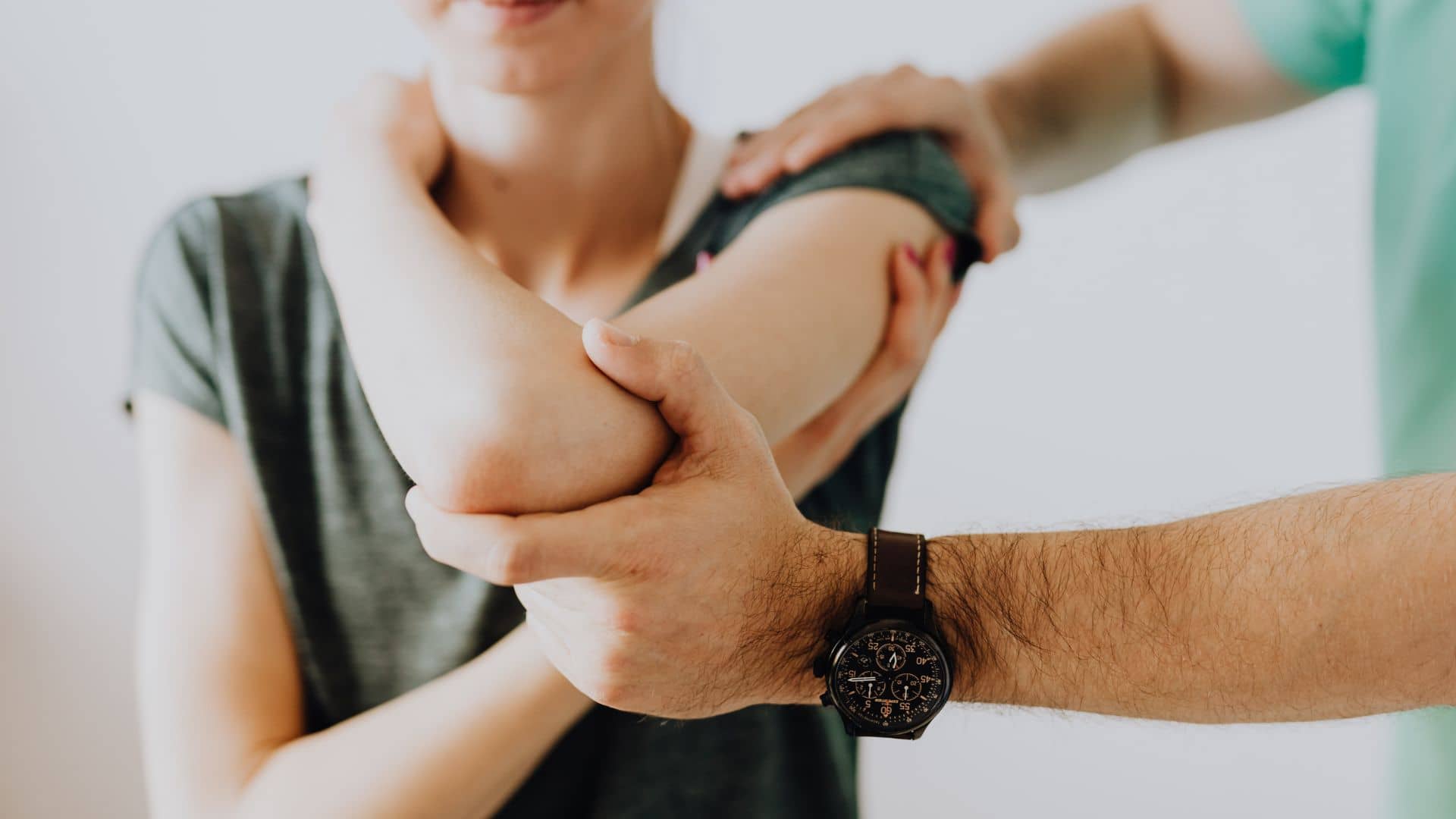When you perform a push up, your chest, shoulders, triceps, and core muscles all engage to lift and lower your body. This means that you are putting a lot of strain on these muscles, causing microscopic tears in the muscle fibers. These tears are a normal part of the muscle-building process, but they can also cause soreness and stiffness.
Here are five reasons why push ups might be making your arms sore: you’re using incorrect form, you’re doing too many push ups, you’re not allowing enough recovery time, you’re not warming up properly, or you’re not cooling down properly
Table of Contents
ToggleIncorrect form.
Push-ups are a great exercise for building upper body strength, but it’s important to perform them with proper form to avoid injury and maximize their benefits.
The correct form for push-ups involves placing your hands on the ground shoulder-width apart, and keeping your body in a straight line from your head to your heels.
it’s important to keep your elbows tucked in towards your body as you lower yourself towards the ground. This allows for proper activation of the chest, triceps, and shoulder muscles, while minimizing strain on the wrists and elbows.
If you’re experiencing soreness after performing push-ups, it’s possible that you’re not using the correct form.
Take some time to review your technique and make adjustments as necessary to avoid further strain on your muscles.
With consistent practice and proper form, push-ups can be an effective exercise for building strength and endurance in the upper body.
Too Many push ups.
Push-ups are a great exercise for building upper body strength and endurance, but it’s important to gradually increase the number of reps you do to avoid soreness and injury.
If you’re not used to doing push-ups, starting with a smaller number of reps is recommended.
It’s important to gradually increase the number of push-ups you do over time as your muscles get stronger.
This will help prevent soreness and reduce the risk of injury. You can start by doing a few push-ups each day, and gradually add more reps as you feel comfortable.
Another important factor to consider is rest. Your muscles need time to recover after exercise, so it’s important to give them a break between workouts.
This will help prevent soreness and reduce the risk of injury.
it’s important to listen to your body when it comes to push-ups. If you’re experiencing soreness or pain, take a break and allow your muscles to recover.
Gradually increasing the number of reps you do over time can help you build strength and endurance while minimizing the risk of injury.

Not allowing enough recovery time.
Recovery time is a crucial aspect of any workout routine, including push-ups.
When you perform push-ups, your muscles experience small tears that need time to heal and repair in order to grow stronger.
If you’re not allowing enough recovery time between push-up workouts, you may be putting yourself at risk for soreness and even injury.
It’s generally recommended to give your muscles at least 48 hours of rest between push-up workouts.
This will allow your muscles to fully recover and repair any damage from the previous workout.
Over time, this will help you build strength and endurance without experiencing excessive soreness or fatigue.
If you’re experiencing soreness or fatigue after push-up workouts, it may be a sign that you’re not allowing enough recovery time.
Consider taking a break from push-ups for a few days or reducing the number of reps you do in each workout.
As your muscles become stronger, you can gradually increase the frequency and intensity of your push-up workouts while still allowing enough time for recovery.
Not warming up properly
Warming up is an essential part of any workout routine, including push-ups. A proper warm-up helps to prepare your muscles for the upcoming activity, increase blood flow, and reduce the risk of injury.
Before you start your push-up workout, it’s important to perform some light cardio or dynamic stretches.
This can include jogging in place, high knees, or jumping jacks to get your blood flowing and your heart rate up.
Dynamic stretches like arm circles, shoulder rolls, and hip rotations can also help to loosen up your muscles and prepare them for the work ahead.
In addition to warming up before your push-up workout, it’s also important to cool down afterwards.
This can include performing some static stretches to help your muscles relax and recover. Holding stretches for 20-30 seconds can help to increase flexibility and reduce soreness.
By taking the time to properly warm up and cool down before and after your push-up workout, you can help to minimize the risk of injury and maximize your results.
Not cooling down properly
Cooling down and stretching after a push-up workout is just as important as warming up beforehand. It can help prevent soreness, stiffness, and injury, while also improving flexibility and range of motion.
After your push-up workout, take a few minutes to stretch your chest, shoulders, triceps, and core.
This can include stretches like the downward dog pose, child’s pose, and cat-cow stretch. Hold each stretch for 20-30 seconds and breathe deeply to allow your muscles to relax and recover.
Stretching can also help to reduce muscle tension and promote circulation, which can help to speed up the recovery process.
By taking the time to stretch after your push-up workout, you’ll improve your overall flexibility and reduce the risk of injury in future workouts.
Remember, cooling down and stretching is an important part of any workout routine, so don’t skip it! Taking a few minutes to stretch after your push-up workout can make a big difference in your overall fitness and well-being.
Push-ups are a great exercise for building upper body strength, but they can also cause soreness in the arms. This soreness is often due to the fact that push-ups target several muscle groups in the arms, including the triceps, biceps, and chest muscles.
When you perform push-ups, these muscles are activated and work together to lift your body weight. This can cause microscopic tears in the muscle fibers, which can lead to soreness and inflammation.
Here is a chart that shows the different muscle groups that are targeted during a push-up exercise:
| Muscles Targeted | Primary Function |
|---|---|
| Triceps | Extend the elbow joint |
| Pectoralis Major | Adducts and flexes the shoulder joint |
| Deltoids | Abducts and flexes the shoulder joint |
| Serratus Anterior | Protracts the shoulder blades |
| Rectus Abdominis | Trunk stabilization |
| Obliques | Trunk stabilization |
As you can see, push-ups work multiple muscle groups in the arms and upper body, which can lead to soreness and fatigue. However, with proper warm-up, cool down, and recovery time, you can minimize the risk of soreness and enjoy the benefits of this effective exercise.
Reasons Why Push-Ups Make Your Arms Sore:
| Reasons | Explanation |
|---|---|
| Muscle Strain | Push-ups work multiple muscle groups in the arms and upper body, which can lead to soreness and strain in these muscles. |
| Lack of Warm-Up | Skipping a warm-up before your push-up workout can make your muscles more susceptible to strain and injury. |
| Overtraining | Doing too many push-ups or not giving your muscles enough time to recover can lead to soreness and fatigue. |
| Poor Form | Improper form during push-ups can put unnecessary strain on your muscles and joints, leading to soreness and injury. |
| Lack of Stretching | Failing to stretch after your push-up workout can lead to soreness and stiffness in your muscles. |
Ways to Fix Soreness from Push-Ups:
| Solutions | Explanation |
|---|---|
| Proper Warm-Up | Always start your push-up workout with a proper warm-up to get your muscles loosened up and ready to work. |
| Gradual Progression | Gradually increase the number of push-ups you do over time, rather than doing too many too soon. |
| Proper Form | Ensure you are performing push-ups with the correct form to avoid unnecessary strain on your muscles and joints. |
| Rest and Recovery | Take rest days between push-up workouts to allow your muscles to rest and recover. |
| Stretching and Cool-Down | Stretching after your workout and doing a cool-down can help to reduce soreness and stiffness in your muscles. |
By following these tips, you can prevent and reduce soreness in your arms from push-ups and enjoy the benefits of this effective exercise.
Conclusion
In conclusion, push-ups are an excellent exercise for building upper body strength, but they can also cause soreness in the arms.
This soreness is typically due to muscle strain, lack of warm-up, overtraining, poor form, and lack of stretching. However, by following the tips we’ve discussed, you can minimize the risk of soreness and enjoy the benefits of this exercise.
Remember to always warm-up before your workout, gradually increase your push-up reps over time, use proper form, take rest and recovery days, and stretch after your workout.
By taking care of your muscles and giving them the time and rest they need, you can achieve your fitness goals and reduce the risk of injury.
So next time you feel sore after a push-up workout, remember that it’s a sign that you’re challenging your muscles and making progress. Keep pushing.


